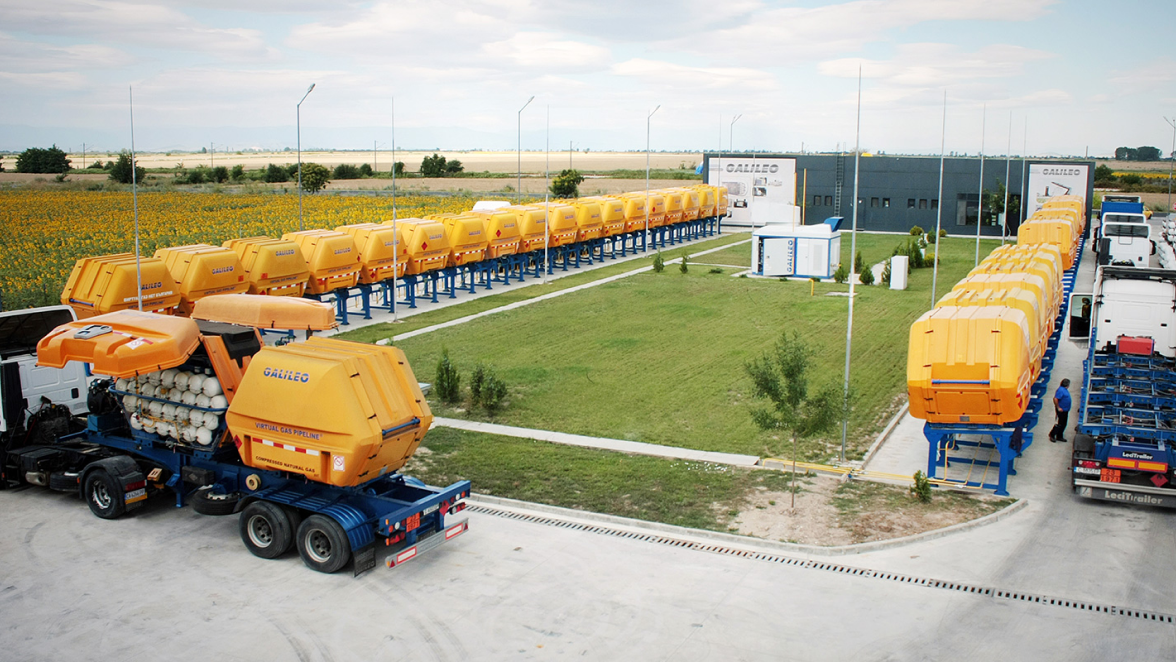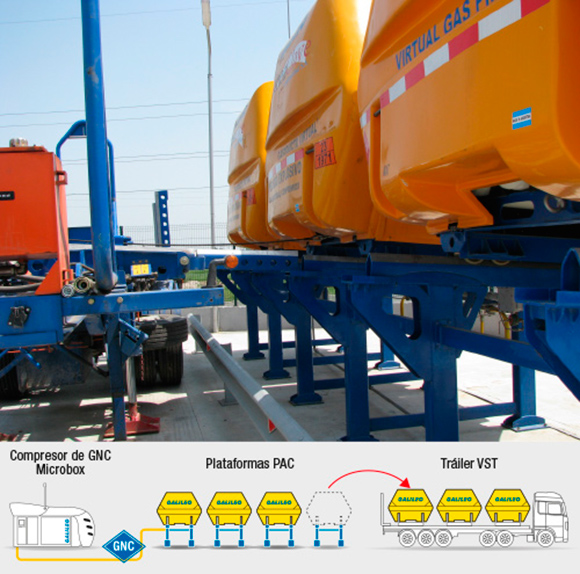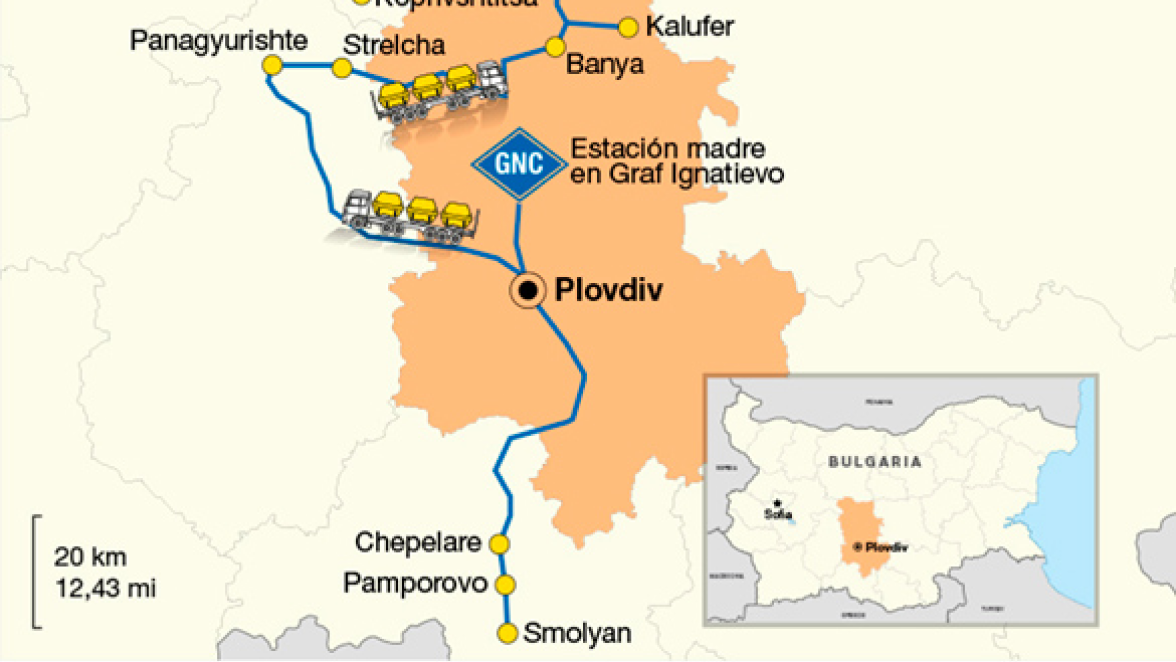Plovdiv, Bulgaria
Galileo’s Virtual Pipeline™ improves quality of life in Bulgaria
Providing heating to homes and benefits to industry, transport, sports and tourism.

In the province of Plovdiv, Bulgaria, the Virtual Pipeline™ technology, engineered by Galileo Technologies, allows gasification in 13 municipalities. Among the centers of economic activity favored by this technology, the main ski resort of the country and one of the major worldwide factories of winter sports items stand out.
The initiative is headed by CNG Maritza, who represents Galileo Technologies in Bulgaria, and it represents the greatest European project of gas distribution, aside from the conventional pipeline networks. The new system improves the quality of approximately 100,000 inhabitants that currently satisfy their heating and fueling needs at a low cost and preserving the environment.
The Virtual Pipeline expands the reach of the natural gas distribution infrastructure
In the benefited communities area, the laying of conventional pipelines was unfeasible due to the absence of large consumption centers that could allow the recovery of the investment. The Virtual Pipeline solves this problem in these scenarios, extending the reach of the gas source through the existing vial network.
With this vision, CNG Maritza installed a mother station of Virtual Pipeline in Graf Ignatievo. There, 3 Microbox™ CNG compressor packages, connected to the network that supplies this city, reduce the natural gas volume with a pressure of 3,625 pounds per square inch (psi) and provide 148,100 gallons of gasoil equivalent per day (GGE/d) of Compressed Natural Gas (CNG).

Virtual Pipeline Mother station in Graf Ignatievo.
CNG transportation
Once converted into CNG, the fluid is sent from the compressors to the MAT™ modular containers, where it is stored for future distribution.
As regards transportation, the MAT are transferred from the PAC™ support and load platforms to the VST™ trailers through an anchorage mechanism controlled by the truck’s driver.
With a storage capacity of 481 GGE per unit, the MAT CNG containers can be distributed individually. This configuration allows each consumption center or daughter station to receive the number of MATs according to their daily gas demand, eliminating unnecessary and excessive costs of transportation, as it happens with the distribution systems based on tube-trailers.
Once at each daughter station, the VST trailer easy-to-operate mechanisms slide the filled MATs over the unloading platforms PAD™. Simultaneously, the VST removes the empty MATs and the truck continuous its route towards the next daughter station.
Supply of natural gas to communities
Upon arrival at each daughter station, the easy-to-operate mechanisms of the VST trailer slide the filled MATs onto the PAD® unloading platforms. Simultaneously, the VST removes the empty MATs, and the truck continues its route to the next daughter station.

At mother stations, MAT loaded with CNG are transferred from PAC™ platforms to VST™ trailers for further transportation.
The system is capable of adapting to the demand of each daughter station through the connection between the MATs and the Pressure Regulating Stations PRP™ that supply natural gas at the output pressure and flow range required by final consumers.
In the case of urban centers, daughter stations allow for the decompression of the fluid and transfer it to the underground pipeline network that distributes the gas to each community at pressure ranges between 25 and 0.5 micro-pascals (mPA).
This way, residential consumers replaced the expensive bottled gas for a domestic consumption experience identical to that of the homes in large urban centers.
Residential consumers replaced the expensive bottled gas for a domestic consumption experience identical to that of the homes in large urban centers.
Benefits to regional economy
At the industrial and tourism centers of the region, the availability of natural gas in the form of CNG allows to replace the consumption of traditional fuels, such as: gasoil, diesel, fuel-oil and LPG, among others. The change reduces the pollutant emission rate and generates savings in fuel cost.
This is what happens in Chepelare, headquarters of Atomic, a company that employs 800 people and manufactures skies, boots, sticks and snowboards on their own brand and also for the most famous brands specialized in winter sports. The same situation occurs at the alpine ski resort of Pomporovo, with a pipeline distribution network of 22,000 lineal meters (13,670 miles) to cover the heating needs of hotels and stores. Or even in Pirdov, Aurubis seat, whose copper concentrates processing plant employs 820 people to produce copper anodes and cathodes and copper byproducts such as sulfuric acid and fayalite.
The gasification process derived from the Virtual Pipeline application improved connectivity between cities: in Smolyan, the medium-distance transport company Rozhen Express replaced diesel for CNG, reducing the environmental impact of its autobuses fleet.
Continuous monitored gas supply
Through the Virtual Pipeline, gas supply is permanent and continuous: when the CNG meter of the MATs is low, daughter stations automatically demand refill. At the same time, each circuit stage is monitored 24 hours per day through Galileo’s SCADA System to guarantee gas availability.
Currently, the Virtual Pipeline managed by CNG Maritza has 6 VST trailers with a daily distribution capacity of 80 MATs, containing 38,500 GGE of natural gas, and satisfying the demand of 8 daughter stations.

MATs distribution routes.
New gas networks fueled by Virtual Pipeline
| Municipality with VP daughter station | Population (inhabitants) | Surface km2 / mi2 |
Altitude m / ft |
Lineal extension of municipality’s gas network m / ft |
| Karlovo | 25,770 | 102.173 / 39.449 | 452 / 1.483 | 28.000 / 91.864 |
| Chepelare | 8.045 | 3.192 / 1.232 | 1.232 / 4.042 | 8.060 / 26.444 |
| Pamporovo Resort | - | - | 1.650 / 5.413 | 22.000 / 72.178 |
| Smolyan | 29.562 | 73.681 / 28.448 | 999 / 3.278 | 84.000 / 275.591 |
| Pirdop | 7.545 | 90.148 / 34.806 | 696 / 2.283 | 18.000 / 59.055 |
| Zlatitsa | 5.045 | 67.538 / 26.076 | 696 / 2.283 | 16.000 / 52.493 |
| Panagyurishte | 17.957 | 32.806 / 12.666 | 550 / 1.804 | - |
Changes as of the arrival of the Virtual Pipeline
- Karlovo’s gas network will extend to Banya, Kalofer, Klissura, Karnare and Vedrare and minor villas.
- In the city of Chepelare, Atomic, one of the main worldwide manufacturers of winter sport items, has replaced diesel consumption for natural gas.
- Hotels, stores and restaurants of the Pamporovo Resort have replaced diesel and bottled gas for network gas to meet their daily heating needs. In this tourist destination, the network satisfies an annual gas demand of 10 million m3 from 70 consumers.
- The transport company Rozhen Express has renewed its fleet with CNG autobuses and has its own filling station for this fuel. Smolyan’s gas network will extend to Levochevo and Stoykite villas.
- Aurubis has reduced polluting emissions in its copper concentrate processing plant.
- Asarel Medetcopper mining has replaced the fuel of its power station for natural gas, to complement its policy of environmentally responsible exploitation.
- Residential consumers have replaced the expensive bottled gas for a domestic consumption experience identical to that of the homes in large urban centers.
MAT-B: flexibility focused on the smaller consumers
CNG Maritza’s response also covers the needs of those consumption centers with a daily demand of natural gas inferior to 321 GGE. In order to serve these consumers, the Virtual Pipeline operates with a modality of gas distribution in bulk, based on the MAT-B containers.
Equipped with recompression booster and dispenser, the MAT-B works as a mobile CNG station that supplies fixed storage modules, called Mini-MAT™ .
The Mini-MAT can be directly docked to the MAT-B and storage up to 321 GGE of CNG at a pressure of 2,900 psi, supplying gas at a pressure between 25 mPA and 0.5 mPA to a domestic network. This way, with a single equipment of minimum dimensions, the Mini-MAT brings the benefits of the discharge PAC column and the PRP from daughter stations designed for larger consumers. This modality covers the gas demand for heating in public schools in Graf Ignatievo, Stroevo, Manole and Banya.

Distribution of gas in bulk.
Financing and Awards
NG Maritza introduced the Virtual Pipeline in Bulgaria in 2006 for Karlovo city gasification. The project received the support of the Bulgarian government and rapidly extended to other cities with the financing of the Kozloduy International Decommissioning Support Fund (KIDSF), aimed at updating the energetic matrix of the region and managed by the European Bank for Reconstruction and Development (EBRD). In 2011, the introduction of the Virtual Pipeline and the satisfactory levels reached by the users determined that CNG Maritza should be awarded the golden medal of the Autumn International Fair that took place in Plovdiv.
Outlook
In the case of the Virtual Pipeline, modular equipments perform the conditioning of natural gas, the compression to obtain CNG, the transportation, and the pressure regulation at the consumption level. This kind of configuration allows the system to increase its capacity in every module to meet the natural gas demand as it changes. The result is a reasonable balance between operative costs and investment, stimulating a virtuous circuit of economic expansion and wellbeing based on clean and low cost energy.
With a long-term perspective CNG Maritza accompanied the construction of its mother station in Graf Ignatievo with that of a plant for the manufacturing of MATs wich will be used to increase gas transportation possibilities.
Currently, this plant– which operates pursuant to Galileo Technologies’ license – has an annual production capacity of 120 MATs.
Towards the future, the goal is to have the capacity of transportation that is needed to attend other regions of Bulgaria or even other European countries interested in reproducing this successful experience.


